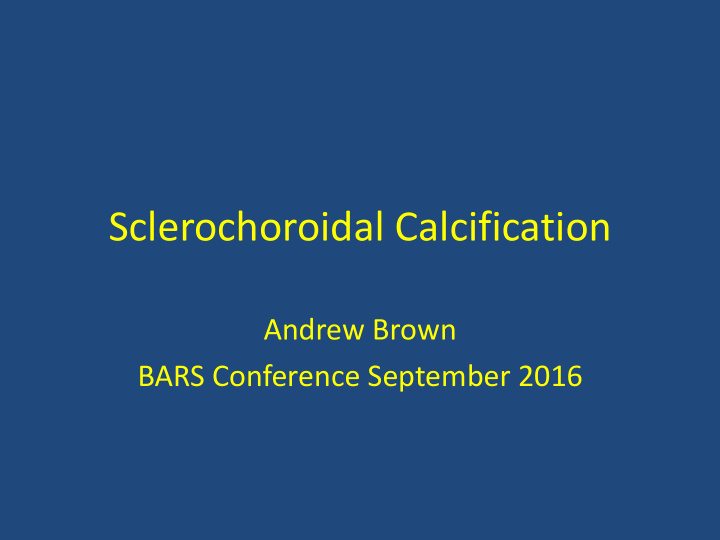



Sclerochoroidal Calcification Andrew Brown BARS Conference September 2016
Case Presentation • 62 year old white Caucasian female • Newly diagnosed T2DM – 1 st Screening • No visual symptoms • Regularly attends the renal physicians – Gitelman’s Syndrome • Referred by O.O. 10 years ago following a routine EE – seen in HES and discharged
Right Eye Macula Centred
Left Eye Macula Centered
• Clinical Features of Sclerochoroidal Calcification • Causes • Differential diagnosis • Learning points
Sclerochoroidal Calcification • Benign intra-ocular deposition of calcium • Commences within the sclera and causes secondary rarefaction of the choroid • Rod dysfunction (on ERG testing) • Detected as incidental finding • Older white patients (median age 70 years) • Unilateral? Bilateral?
Sclerochoroidal Calcification • Multiple yellow-white sub-retinal lesions • Superior to supero-temporal retinal arcade • Mid-peripheral (between arcade and equator) • Minimally elevated • RPE atrophy • May be complicated by choroidal neovascular membranes and sub-retinal fluid
Causes • Idiopathic • Hypercalcaemia Hyperparathyroidism Vitamin D intoxication Sarcoidosis • Metabolic Gitelman syndrome Bartter Syndrome • Hereditary Familial articular chondrochalcinosis
Differential Diagnosis • Choroidal Metastasis • Choroidal Melanoma • Choroidal Naevus • Choroidal Osteoma
Investigations • OCT – EDI • OCT – Autofluorescence • Ophthalmic ultrasound • Optos Widefield imaging
Sclerochoroidal calcification
Sclerochoroidal calcification
Choroidal Metastasis
Choroidal Metastasis
Choroidal Melanoma
Choroidal Melanoma
Choroidal Melanoma
Choroidal Osteoma
Choroidal Naevus
Learning Points • Yellow white mid-peripheral lesions • White adults • Asymptomatic • Important mimicking disease • Should be screened for metabolic disorders • Occasionally have sight threatening complications
Thank you Any Questions?
Recommend
More recommend